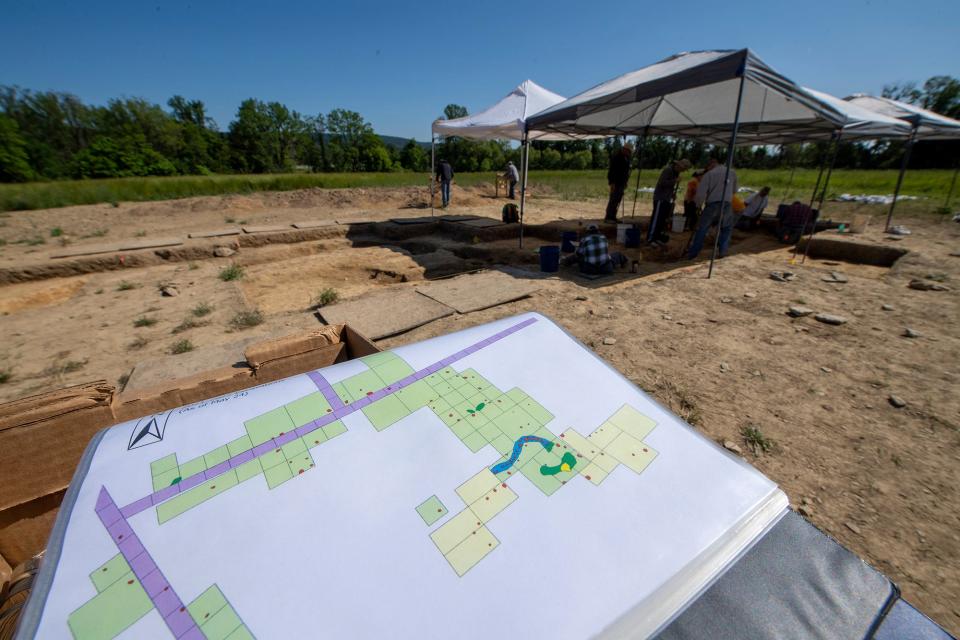Uncovering a Revolutionary POW camp in York County: 'It will ... be a tourist destination'
On a recent sunny morning, volunteers used shovels and hand tools as they dug into the earth in hopes of uncovering more of the footprint of a Revolutionary War POW camp in Springettsbury Township.
Lead archaeologist John Crawmer and volunteers found evidence of the site of Camp Security last year when they discovered post holes of the stockade under the topsoil in a field off of Locust Grove Road. It drew national attention as the site is believed to be the last undeveloped Revolutionary War prison camp in the country.
This spring, the archaeologists and volunteers are working to uncover more of the footprint of the camp. They have no idea what the shape of the stockade was, Crawmer said. Some in the 18th century were round, while others were square.

More: 'We finally found it': Evidence of Revolutionary War POW camp site in York County unearthed
"Right now, it's doing a weird serpentine pattern ...," he said. "We can't make much of it right now because you sort of just need to see the bigger picture to know what that's about or why that's happening."
It's not clear at this point how long it will take to uncover the footprint of the camp.
Soft, slightly darker soil in the stockade
Camp Security, which held British prisoners of war during the Revolutionary War, operated between the summer of 1781 and the spring of 1783.
When wooden posts sit in the ground for years, the wood rots a little bit and changes the color of the soil in the earth. Archaeologists typically look for good post molds, but those don't exist at the Camp Security site. The stockade was removed after a short period of time.
"It is enough for us to see a different soil color, but that soil color is extremely subtle," Crawmer said.

That's why the volunteers worked under canopies on that recent morning because the bright sunlight would have bleached out the color.
Crawmer said the soil, which is slightly darker in color, is soft. It also contains charcoal, which indicates that the wooden posts had started to degrade.

Crawmer explained that they can see evidence − a disturbance in the earth − where the wooden posts had been yanked back to remove them.
While volunteers worked in the area of the stockade trench, assistant archaeologist Jane Skinner used a drone to capture images of the site. She turns the photos into 3D models to gather more information.
They can use the models in several different ways, such as to get elevations and accurate coordinate points. It allows archaeologists and volunteers to spend more time digging in the field, she said.
Skinner, who is a researcher at Penn State University, has an ancestor who served as a guard at Camp Security for four to six months. She's not from Pennsylvania, so she was surprised to learn that about her family history.
In addition to her family connection and having friends working at the site, she's interested in outreach and involving local communities in archaelogical digs. With this project, it allows people to connect themselves to the Revolutionary history of York.
"I'm glad we have a stockade," she said. "I'll be excited to see what artifacts we get."

The hunt for Camp Security: Where exactly is it, and will archaeologists find it?
Future of the Camp Security site
Carol Tanzola, president of the Friends of Camp Security, felt vindicated when the dig uncovered the stockade last year. She fought for years to save the site from development.
Finding the camp will put Springettsbury Township on the map, and "... it will eventually be a tourist destination," she said.
She expects that some people who had ancestors at the camp will want to come see it.
The land is owned by Springettsbury Township, which is in the early stages of developing a master plan for the site, manager Mark Hodgkinson said.
The development of the plan is expected to take 18 to 24 months to complete, he said.
The municipality received grant funding from the Pennsylvania Department of Conservation and Natural Resources and the York County Planning Commission for it.
Rick Geidel, a volunteer and retired archaeologist from York Township, said it was a hard-fought battle to make sure that Camp Security didn't become like other Revolutionary War POW camps and be destroyed by development.
"It's a privilege to be out here trying to document this thing and whatever I can do to help out," he said.

Learn more about the archaeological dig
Want to see the archaeological dig for yourself?
The site will be open to the public from 10 a.m. to noon on both Monday, June 5 and Saturday, June 10.
The Friends of Camp Security also could use financial help with the archaeological work. Donations can be made on Camp Security website or mailed to Friends of Camp Security, P.O. Box 20008 York, PA 17402.
For more information, visit campsecurity.org.
This article originally appeared on York Daily Record: Revolutionary War POW camp in York County, Pa. revealing its footprint
